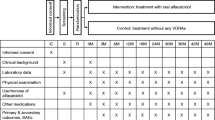Abstract
Background
Vitamin D deficiency is common in hemodialysis (HD) patients. The aim of this study was to determine whether HD patients with low 25-hydroxyvitamin D [25(OH)D] levels are at increased risk of mortality.
Methods
This was a prospective cohort study of Japanese HD patients. We selected all patients with measured serum 25(OH)D levels at the time of entry. We assessed the impact of low serum 25(OH)D levels on the long-term mortality of HD patients by performing Cox regression analyses. Associations between serum 25(OH)D levels and all-cause mortality were also investigated.
Results
Data from 100 patients (mean age 61.0 ± 11.8 years, 64 % males) were available. There was a high prevalence (55 %) of 25(OH)D insufficiency < 20 ng/ml, and 51 % of study subjects were treated with alfacalcidol. Twenty-four patients died during a follow-up period of 4.6 years. There were no significant associations between serum 25(OH)D levels and all-cause mortality (p = 0.777). After adjustments for possible confounders, the hazard ratio (with 95 % CI) for all-cause mortality was 1.091 (1.024–1.167) for age, 0.734 (0.566–1.167) for dialysis vintage, 1.012 (0.995–1.031) for serum total cholesterol values, 2.028 (1.093–3.701) for serum phosphate levels, and 0.291 (0.088–0.855) for treatment with alfacalcidol. A survival advantage of alfacalcidol treatment was observed (log-rank, p = 0.0150). The group of subjects whose serum (25(OH)D level was <20 ng/ml and who were not treated with alfacalcidol had the highest mortality rate.
Conclusion
Vitamin D deficiency in HD patients who had not taken vitamin D receptor agonist (VDRA) is associated with an increased risk of all-cause mortality. VDRA supplementation may suppress chronic inflammation and have some advantage for mortality of HD patients with vitamin D deficiency.




Similar content being viewed by others
References
Cuppari L, Garcia Lopes MG, Kamimura MA. Vitamin D biology: from the discovery to its significance in chronic kidney disease. J Ren Nutr. 2011;21:113–6.
Holick MF. Vitamin D deficiency. N Engl J Med. 2007;357:266–81.
Bouillon R, Carmelliet G, Verlinden L, van Etten E, Verstuyf A, Luderer HF, et al. Vitamin D and human health: lessons from vitamin D receptor null mice. Endocr Rev. 2008;29:726–76.
Inaguma D, Nagaya H, Hara K, Tatematsu M, Shinjo H, Suzuki S, et al. Relationship between serum 1,25-dihydroxyvitamin D and mortality in patients with pre-dialysis chronic kidney disease. Clin Exp Nephrol. 2008;12:126–31.
Barreto DV, Barreto FC, Liabeuf S, Temmar M, Boitte F, Choukroun G, et al. Vitamin D affects survival independently of vascular calcification in chronic kidney disease. Clin J Am Soc Nephrol. 2009;4:1128–35.
Ravani P, Malberti F, Tripepi G, Pecchini P, Cutrupi S, Pizzini P, et al. Vitamin D levels and patient outcome in chronic kidney disease. Kidney Int. 2009;75:88–95.
Wolf M, Shah A, Gutierrez O, Ankers E, Monroy M, Tamez H, et al. Vitamin D levels and early mortality among incident hemodialysis patients. Kidney Int. 2007;72:1004–13.
Pecovnik-Balon B, Jakopin E, Bevc S, Knehtl M, Gorenjak M. Vitamin D as a novel nontraditional risk factor for mortality in hemodialysis patients. Ther Apher Dial. 2009;13:268–72.
Mehrotra R, Kermah DA, Salusky IB, Wolf MS, Thadhani RI, Chiu YW, et al. Chronic kidney disease, hypovitaminosis D, and mortality in the United States. Kidney Int. 2009;76:977–83.
Wang AY, Lam CW, Sanderson JE, Wang M, Chan IH, Lui SF, et al. Serum 25-hydroxyvitamin D status and cardiovascular outcomes in chronic peritoneal dialysis patients: a 3-y prospective cohort study. Am J Clin Nutr. 2008;87:1631–8.
Chonchol M, Cigolini M, Targher G. Association between 25-hydroxyvitamin D deficiency and cardiovascular disease in type 2 diabetic patients with mild kidney dysfunction. Nephrol Dial Transplant. 2008;23:269–74.
Matias PJ, Ferreira C, Jorge C, Borges M, Aires I, Amaral T, et al. 25-Hydroxyvitamin D3, arterial calcifications and cardiovascular risk markers in haemodialysis patients. Nephrol Dial Transplant. 2009;24:611–8.
Yamshchikov AV, Desai NS, Blumberg HM, Ziegler TR, Tangpricha V. Vitamin D for treatment and prevention of infectious diseases: a systematic review of randomized controlled trials. Endocr Pract. 2009;15:438–49.
Adorini L, Penna G. Control of autoimmune diseases by the vitamin D endocrine system. Nat Clin Pract Rheumatol. 2008;4:404–12.
Tentori F, Albert JM, Young EW, Blayney MJ, Robinson BM, Pisoni RL, et al. The survival advantage for haemodialysis patients taking vitamin D is questioned: findings from the Dialysis Outcomes and Practice Patterns Study. Nephrol Dial Transplant. 2009;24:963–72.
Kalantar-Zadeh K, Kovesdy CP. Clinical outcomes with active versus nutritional vitamin D compounds in chronic kidney disease. Clin J Am Soc Nephrol. 2009;4:1529–39.
Eknoyan G, Levin A, Levin NW. Bone metabolism and disease in chronic kidney disease. Am J Kidney Dis. 2003;42:1–201.
Doorenbos CR, van den Born J, Navis G, de Borst MH. Possible renoprotection by vitamin D in chronic renal disease: beyond mineral metabolism. Nat Rev Nephrol. 2009;5:691–700.
Sugiura S, Inaguma D, Kitagawa A, Murata M, Kamimura Y, Sendo S, et al. Administration of alfacalcidol for patients with predialysis chronic kidney disease may reduce cardiovascular disease events. Clin Exp Nephrol. 2010;14:43–50.
Shoji T, Shinohara K, Kimoto E, Emoto M, Tabata H, Koyama H, et al. Lower risk for cardiovascular mortality in oral 1alpha-hydroxy vitamain D3 users in a hemodialysis population. Nephrol Dial Transplant. 2004;19:179–84.
Naves-Diaz M, Alvarez-Hernandez D, Passlick-Deetjen J, Guinsburg A, Marell C, Rodriguez-Puyol D, et al. Oral active vitamin D is associated with improved survival in hemodialysis. Kidney Int. 2008;74:1070–8.
Ogawa T, Ishida H, Akamatsu M, Matsuda N, Fujiu A, Ito K, et al. Relation of oral 1alpha-hydroxy vitamin D3 to the progression of aortic arch calcification in hemodialysis patients. Heart Vessels. 2010;25:1–6.
Acknowledgments
This study was supported by a Grant-in-Aid from the Japan Promotion Society for Cardiovascular Diseases.
Conflict of interest
We have no conflict of interest to disclose.
Author information
Authors and Affiliations
Corresponding author
About this article
Cite this article
Ogawa, T., Kyono, A., Sato, M. et al. Vitamin D receptor agonist supplementation and suppression of inflammation may have advantage for all-cause mortality in hemodialysis patients. Clin Exp Nephrol 16, 779–785 (2012). https://doi.org/10.1007/s10157-012-0626-2
Received:
Accepted:
Published:
Issue Date:
DOI: https://doi.org/10.1007/s10157-012-0626-2




